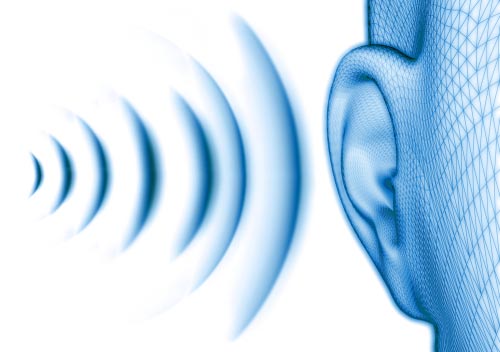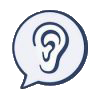Have you ever noticed that you don’t hear yourself talking? Or that the first crack of thunder in a thunderstorm is louder than all the others that come after it?
Healthy ears have the ability to shut out excessively loud or repetitive sounds with the acoustic reflex. The acoustic reflex is an involuntary contraction of muscles in the middle ear when you start to talk or sing, or when you hear a loud sound.

What Happens During the Acoustic Reflex?
The acoustic reflex stops the vibrations of three small bones known as the ossicles. These three tiny bones, commonly known as the hammer, anvil, and stirrup, transmit vibrations from the outer ear to the fluid-filled cochlea (also known as the labyrinth) of the ear. Without these three bones, your hearing would be severely limited. The acoustic reflex activates the stapedius and tensor tympani muscles to pull the “stirrup” bone away from the ear canal to reduce the transmission of sound to the inner ear.
Every sound doesn’t trigger the acoustic reflex. If this were the case, we couldn’t hear anything. Most people experience the acoustic reflex at an acoustic threshold of 70 to 100 decibels. The acoustic reflex is usually triggered by sounds that are unpleasantly loud. This level is typically 10 to 20 decibels lower than sound loud enough to damage the ears.
The acoustic reflex and the acoustic threshold can be evaluated by professional audiologists with tools that measure acoustic intermittence, how often the perception of sound is interrupted by the acoustic reflex. Extensive studies of the acoustic reflex have revealed certain well-established facts:
- The stapedius muscles in both ears are connected to a portion of the brain known as the auditory brainstem by the eighth cranial nerve (cranial nerve VIII). Most people will have an auditory reflex in both ears even if they hear a loud sound with just one ear.
- When the ear detects a sound 20 decibels above the auditory threshold, a healthy acoustic reflex reduces the intensity of the sound by about 15 decibels. (That’s not quite the same thing as reducing the intensity of the sound by 75 percent, but there is a significant reduction in the intensity of the sound.)
- The stapedius clamps down on the stirrup bone before you begin to speak or sing, in anticipation of vocalization. This reduces the intensity of the sound of your own voice by about 20 decibels.
The acoustic reflex happens faster than you can think about it, in about 1/100 of a second. That isn’t fast enough to prevent your hearing every loud noise, but it will protect your hearing from loud noises repeated every two or three seconds. The auditory reflex is more protective against low-frequency, loud noises than against high-pitched loud noises.
How Your Audiologist Tests Your Auditory Reflex?
Most hearing exams involve a procedure for testing your auditory reflex called tympanometry. Tympanometry isn’t a test of your hearing. It is a test of how much energy is transmitted through your middle ear. The amount of energy transmitted through your energy ear corresponds to how much your eardrum moves in response to sound.
In this test, the audiologist places a probe that looks something like an earphone into each ear. A small device attached to the probe then pushes air into your ear. Since the reflex involved in this test is automatic, all you have to do is to sit still.
Your audiologist will see a graph that tells how much your eardrum moves. If your eardrum moves too much, the audiologist may infer that you have a defective auditory reflex, depending on the intensity of the sounds tested.
Tympanometry can also reveal defects in your eardrum.
Testing your acoustic reflex can reveal significant issues in your neurological health. Two of the first things your audiologist would notice are an ipsilateral acoustic reflex—a reaction to loud sound in the same ear that was exposed to it—or a contralateral acoustic reflex—a reaction to loud sound in the ear that wasn’t exposed to it without a reaction in the ear that was.
The combinations of acoustic reflexes can reveal that one or both ears have damage to its conducting bones. They can reveal nerve damage in one or both ears. And they can show bone deterioration in one ear and nerve damage in the other. There are patterns that can reveal a kind of tumor known as schwannoma, brainstem damage, or general auditory nerve damage.
Most of the time, of course, acoustic reflex testing doesn’t reveal any drastic hearing problem. It simply pinpoints auditory defects for choosing precisely the kind of hearing aid that will be the most helpful.

Contact Our Audiologists Today
The hearing specialists at Harbor Audiology can provide you with the hearing care you need to achieve the best hearing possible. We can help you choose the best of the most advanced hearing aids.
Harbor Audiology is experienced in filing for VA benefits, and we work with all major insurance plans. We are open most evenings and Saturdays. Harbor Audiology has offices in Tacoma, Gig Harbor, Silverdale, Sequim, Port Angeles, and Federal Way. Request your appointment online today!






